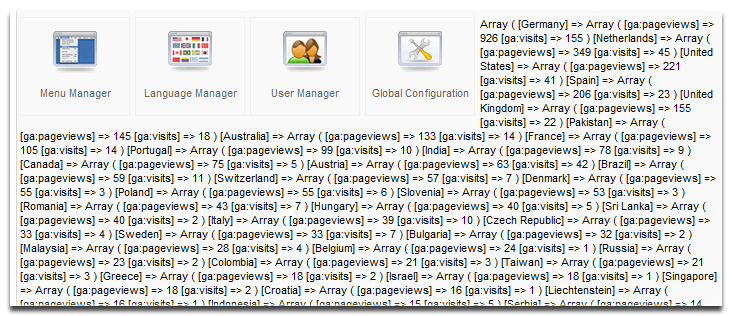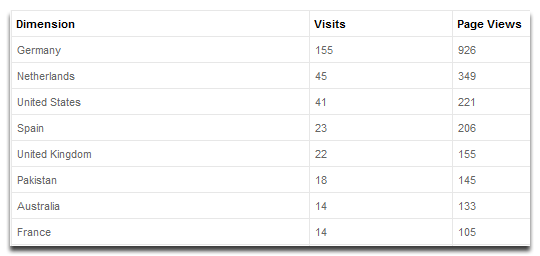Instead of displaying "This is some text that we are going to display" we want to display data from Google Analytics. In order to do this we are going to have to use a php library that connects to the Google Analytics API. We could create one at this point but a quick search on Google turns up the following result.
Download the Google analytics classes and unpack it somewhere on your local machine. Inside you will find two files, "googleanalytics.class.php" and "googleanalyticssample.php". Using your FTP client or on your local machine go to your site directory and navigate to ...administrator/modules/mod_analytics. Create a directory called "lib". Transfer the file "googleanalytics.class.php" to this directory.
This file contains a class of functions that communicate with the Google Analytics API and it was written by Doug Tan.
Now that we have our library we need to include it in our default layout. In your FTP client or on your local machine open the "tmpl" folder and then open the "default.php".
Delete this line from the code:
{codecitation class="brush:php; gutter:false;" width="74.923em"}
echo '<table class="adminlist">This is some text that we are going to display</table>';
{/codecitation}
And paste the following code into the file and save it.
{codecitation class="brush:php; gutter:false;" width="74.923em"}
//Define the path to the lib folder in our module directory.
$path = JPATH_ADMINISTRATOR.DS.'modules'.DS.'mod_analytics'.DS.'lib';
//Define the file name
$file = 'googleanalytics.class.php';
//Load the file so that the functions inside it can be used
require_once($path.DS.$file);
try {
// create an instance of the GoogleAnalytics class using your own Google {email} and {password}
$ga = new GoogleAnalytics('{email}','{password}');
// set the Google Analytics profile you want to access - format is 'ga:123456';
$ga->setProfile('{GA Profile ID}');
// set the date range we want for the report - format is YYYY-MM-DD
$ga->setDateRange('2009-04-01','2009-04-07');
// get the report for date and country showing pageviews and visits
$report = $ga->getReport(
array('dimensions'=>urlencode('ga:country'),
'metrics'=>urlencode('ga:pageviews,ga:visits'),
'sort'=>'-ga:pageviews'
)
);
//print out the $report array
print_r($report);
} catch (Exception $e) {
print 'Error: ' . $e->getMessage();
}
{/codecitation}
You will have to fill in your email, password and Google Analytics profile ID in order to get the code to work. The easiest way to get this is to go to the reporting section of analytics and copy it from the URL.
For example, if your URL looks like "https://www.google.com/analytics/reporting/?reset=1&id=12345678&pdr=20100405-20100505" then you would enter "ga:12345678" into the code as follows:
{codecitation class="brush:php; gutter:false;" width="74.923em"}
$ga->setProfile('ga:12345678');
{/codecitation}
If you now refresh the control panel you should have something that looks like this:

This is a key/value array and doesn't exactly tell us very much in this format! We need to take this data and make it more presentable. In the default.php find this line:
{codecitation class="brush:php; gutter:false;" width="74.923em"}
print_r($report);
{/codecitation}
Replace it with the following code:
{codecitation class="brush:php; gutter:false;" width="74.923em"}
//Create a table and it's headers
echo '<table class="adminlist" style="width:556px"><th>Country</th><th>Visits</th><th>Page Views</th>';
//for each Country => Array( ga:pageviews => x, ga:visits => y )
foreach ($report as $key => $value ){
//Create a table row with 3 columns: country, visits and pageviews
$tablerow = '<tr><td>'.$key.'</td><td>'.$value['ga:visits'].'</td><td>'.$value['ga:pageviews'].'</td></tr>';
//Output the table row to the page
echo $tablerow;
//Create javascript for the Google map element
$map .= "data.setValue(".($i).",0,'".$key."');data.setValue(".($i).",1,".$value['ga:visits'].");";
}
//Close the table
echo '</table>';
{/codecitation}
You should now have a table that looks something like this:

If you want to restrict the number of countries to the top 10 or some other number simply add a counter to the last bit of code as follows:
{codecitation class="brush:php; gutter:false;" width="74.923em"}
//Create a table and it's headers
echo '<table class="adminlist" style="width:556px"><th>Country</th><th>Visits</th><th>Page Views</th>';
//Set $i to zero
$i = 0;
//for each Country => Array( ga:pageviews => x, ga:visits => y )
foreach ($report as $key => $value ){
//If $i is less than 10
if($i<10) {
//Create a table row with 3 columns: country, visits and pageviews
$tablerow = '<tr><td>'.$key.'</td><td>'.$value['ga:visits'].'</td><td>'.$value['ga:pageviews'].'</td></tr>';
//Output the table row to the page
echo $tablerow;
}
//Create javascript for the Google map element
$map .= "data.setValue(".($i).",0,'".$key."');data.setValue(".($i).",1,".$value['ga:visits'].");";
//Add one to $i
$i++;
}
//Close the table
echo '</table>';
{/codecitation}
We now have our visits and page views per country displayed in a table. The $map variable is used to construct javascript that we will need to display our data on a map of the world. Google provides a handy charts API that allows us to do this. The documentation for the geo map chart that we are going to use can be found here.
Place the following code at the end of the default.php.
{codecitation class="brush:php; gutter:false;" width="74.923em"}
//Returns a reference to the global document object
$document = & JFactory::getDocument();
//Some Google javascript
$script="<script type='text/javascript' src='http://www.google.com/jsapi'></script>";
//Adds the script to the document
$document->addCustomTag($script);
//Counts the number of key value pairs in the report array
$countries = count($report);
//Script to construct the geo map
$script=" <script type='text/javascript'>
google.load('visualization', '1', {'packages': ['geomap']});
google.setOnLoadCallback(drawMap);
function drawMap() {
var data = new google.visualization.DataTable();
data.addRows(".$countries.");
data.addColumn('string', 'Country');
data.addColumn('number', 'Visits');
".$map."
var options = {};
options['dataMode'] = 'regions';
var container = document.getElementById('map_canvas');
var geomap = new google.visualization.GeoMap(container);
geomap.draw(data, options);
};
</script>
";
//add the script to the document so that the map is created
$document->addCustomTag($script);
//The div that the script adds the map to
echo "<div id='map_canvas'></div>";
{/codecitation}
This adds the javascript from Google that is required to use the geo map function and also some script that is used to create the map. This may seem confusing but this script was taken directly from here and the only bits that were changed were these parts.
{codecitation class="brush:javascript; gutter:false;" width="74.923em"}
data.addRows(6);
data.addColumn('string', 'City');
data.addColumn('number', 'Popularity');
data.setValue(0, 0, 'New York');
data.setValue(0, 1, 200);
...
{/codecitation}
We have switched 'City' for 'Country' and 'Popularity' for 'Visits' as these are the two variables we are displaying on the map. Our count() function gave us the number of rows for data.addRows(...) and the data.setValue(...) lines are constructed in the foreach loop from before and given the name $map.
When the page loads, the map is added to the div with the name 'map_canvas'. You should see this underneath your table of results.
We are nearly finished! Currently the username, password and profile ID are placed directly in the code. Obviously this is not ideal and a better way to obtain these details would be from the edit module view. To be able to store and retrieve data from this view we need to create some parameters for our module. This is done in the mod_analytics.xml file.
We will also add a line to include the 'lib' folder that we created earlier. This means that this folder will be installed with the module in the same way the "tmpl" folder was at the beginning.
So we replace this code in mod_analytics.xml:
{codecitation class="brush:xml; gutter:false;" width="74.923em"}
<files>
<filename module="mod_analytics">mod_analytics.php</filename>
<folder module="mod_analytics">tmpl</folder>
</files>
{/codecitation}
With
{codecitation class="brush:xml; gutter:false;" width="74.923em"}
<files>
<filename module="mod_analytics">mod_analytics.php</filename>
<folder module="mod_analytics">tmpl</folder>
<folder module="mod_analytics">lib</folder>
</files>
<params>
<param name="email" type="text" label="Email" description="Enter your Google Analytics email here" default="" />
<param name="password" type="password" label="Password" description="Enter your Google Anayltics password here" default="" />
<param name="profileid" type="text" label="Profile ID" desctiption="Enter the ID of the Google Analytics profile you wish to see stats for" default="" />
<param name="daterange" type="radio" default="1" label="Report Range" description = "Select a date range to run reports over" >
<option value="1">Last 7 Days</option>
<option value="2">Last 30 Days</option>
<option value="3">Last 365 Days</option>
</param>
</params>
{/codecitation}
Now when we go to edit our module we will see three text boxes that we can use to enter the analytics username, password and profile id. There will also be a radio button select list where the user can select to view reports over 7, 30 or 365 days.

If we enter details here and save the module configuration then they will still be present when it is reopened. However, we still need to include them in the the default.php. To call them in this file we will use the $params object, which is available to all modules.
Edit the code as follows. After "try {" replace
{codecitation class="brush:php; gutter:false;" width="74.923em"}
// create an instance of the GoogleAnalytics class using your own Google {email} and {password}
$ga = new GoogleAnalytics({email},{password});
// set the Google Analytics profile you want to access - format is 'ga:123456';
$ga->setProfile({GA Profile ID});
// set the date range we want for the report - format is YYYY-MM-DD
$ga->setDateRange('2010-04-01','2010-04-07');
{/codecitation}
with
{codecitation class="brush:php; gutter:false;" width="74.923em"}
// create an instance of the GoogleAnalytics class using your own Google {email} and {password}
$ga = new GoogleAnalytics($params->get('email'),$params->get('password'));
// set the Google Analytics profile you want to access - format is 'ga:123456';
$ga->setProfile('ga:'.$params->get('profileid'));
//Get the daterange param. This value will either be 1,2 or 3
$daterange = $params->get('daterange');
if($daterange == 1) {
//Take 7 days off today's date and format as YYYY-MM-DD
$startdate = date('Y-m-d',time()-7*86400);
} else if ($daterange == 2) {
//Take 30 days off today's date and format as YYYY-MM-DD
$startdate = date('Y-m-d',time()-30*86400);
} else if ($daterange == 3) {
//Take 365 days off today's date and format as YYYY-MM-DD
$startdate = date('Y-m-d',time()-365*86400);
}
//Format today's date as YYYY-MM-DD
$enddate = date('Y-m-d',time());
// set the date range we want for the report - format is YYYY-MM-DD
$ga->setDateRange($startdate,$enddate);
{/codecitation}
When using $params->get('PARAMETER NAME'), the name is the same as the value we set in the xml file.
time() returns us the current time as a UNIX timestamp.
date() helps us format the time the correct way.
And that's it! You should now have a fully functional visitor map that works in the administrator section of your Joomla! website. To create an install package simply download the files into the same directory you started with on your local machine and zip the folder. Don't forget to download the lib folder with the google analytics class!
Here's what the final module looks like when the table is set to display only the top 3 countries:

I hope this tutorial has been of some use for those of you who are trying to get to grips with the design of custom Joomla extensions! Please feel free to leave any comments suggesting ways I could enhance or improve it.
The finished module installer file is available for download below.
